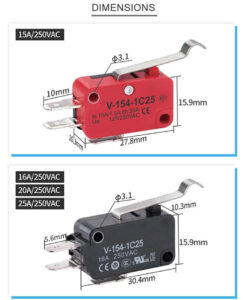
Metal push button switches are widely used in industrial, commercial, and even residential settings due to their durability, tactile feedback, and robust design. However, improper use or installation can lead to safety hazards, including electrical malfunctions, mechanical failures, or even accidents. To ensure optimal performance and user safety, following these key safety guidelines is crucial.
1. Pre-Installation Inspection and Compatibility Check
Before installing a metal push button switch, always verify its specifications against the intended application. Check for critical ratings such as voltage (AC/DC), current capacity, and environmental certifications (e.g., IP67 for water/dust resistance). Mismatched ratings can cause overheating, arcing, or short circuits. Inspect the switch for physical damage—cracks, loose components, or corroded terminals—and ensure the metal casing is free from burrs or sharp edges that could cause injury during handling.

2. Proper Installation Techniques
Correct installation is the foundation of safe operation. Use appropriate tools to secure the switch in its panel or enclosure, ensuring a tight fit to prevent water, dust, or debris ingress. Follow the manufacturer’s wiring diagrams: connect live (phase), neutral, and ground wires correctly to avoid reverse polarity, which may damage the switch or connected equipment. For high-voltage applications, use insulated terminals and reinforce connections with cable ties or clamps to prevent loose wires from causing short circuits. Never overload the switch beyond its rated current; consult the datasheet for load limits.
3. Regular Maintenance and Inspection
Even durable metal switches require routine maintenance to sustain safety. Schedule periodic checks to clean the switch surface (use a dry or slightly damp cloth—avoid corrosive solvents) and lubricate moving parts if recommended by the manufacturer. Inspect for signs of wear, such as faded legends, worn-out buttons, or weakened spring mechanisms that may affect operation. Tighten loose terminals to prevent resistive heating, which can damage the switch and pose a fire risk. Document maintenance records to track performance and identify potential issues early.
4. Environmental Considerations
Metal switches are designed for specific environments, so ensure the operating conditions match the switch’s ratings. In humid or corrosive settings, choose switches with stainless steel or nickel-plated casings and sealed internals to resist rust and chemical damage. In high-temperature areas, confirm the switch can withstand the ambient heat without degrading plastic components or compromising insulation. For outdoor or exposed installations, use weatherproof enclosures and ensure the switch’s IP rating matches the environmental challenges (e.g., IP66 for heavy water jets).

5. Safe Operation Practices
Users must understand proper operation to avoid accidents. Train operators to press the button firmly and release it smoothly—avoid excessive force, which may deform the metal housing or damage internal contacts. Never use tools or sharp objects to activate the switch, as this can scratch the surface or cause uneven pressure, leading to mechanical failure. For emergency stop (E-Stop) switches, ensure they are clearly labeled, easily accessible, and tested regularly to confirm immediate shutdown functionality.
6. Compliance with Standards and Regulations
Adhere to international safety standards such as IEC 61058 for switches, OSHA (USA) or CE (EU) guidelines, and industry-specific regulations. Ensure the switch carries the necessary certifications for your target market, as non-compliant products may face legal issues and compromise user safety. Always source switches from reputable manufacturers who provide detailed technical documentation and safety data sheets (SDS).
By prioritizing pre-installation checks, proper installation, regular maintenance, and safe operation, you can maximize the lifespan of metal push button switches while minimizing risks. Remember, safety is a collective responsibility—always refer to the manufacturer’s instructions and seek professional advice for complex applications.



